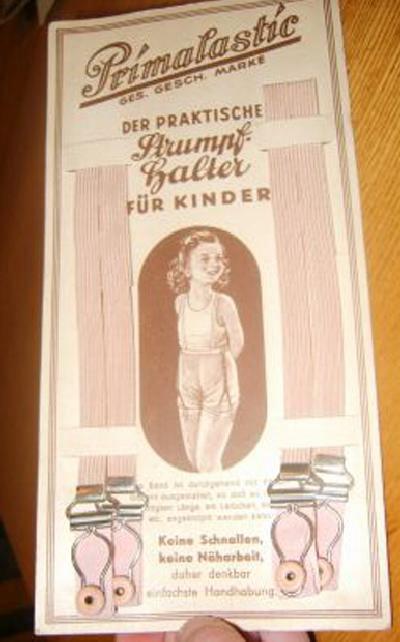
German Clothing Packaging: Primalastic Children's Hose Suporters (1930s)

Figure 1.--This pair of Primalastic children's hose supporters are from the 1930s. They are mounted on the original card as they would be purchased in a shop. The card is not dated, but we suspect that this product was typical of commercial hose supporters during the entire decade.
|
|
This pair of Primalastic children's hose supporters are from the 1930s. They are mounted on the original card as they would be purchased in a shop. The card is not dated, but we suspect that this product was typical of commercial hose supporters during the entire decade. And notice the
length of the stockings, which would indicate to me that the date is
more like 1935-36. These supporters are appropriate for both boys and
girls although the pink color of the elastic indicates a particular
appeal to girls, and a girl model is shown in the illustration.
Presumably the same product could be bought in white or gray--more
appropriate for boys. We know that boys wore long stockings with
supporters just as frequently as girls during the period. The method of
attachment is a bit obscure. I'm not sure how the supporters were
attached to the waist but it was probably by a button or hook at the
top that could be fastened onto the children's underwear or Liebchen.
Primalastic
We have no information about this German company.
Long stockings were commony worn in Germany. Even after World War I when long stockings became less commn in many other countries, they remained widely worn in Germany, especially during the Winter. We have, however, very limited informaion on stocking supporters. One German reader tells us that the kind of elaborate stocking supporters common in America were not widely worn in Germany. More common were make informal, shift devices such as elastic bands or pins. Many children wore Leibchen, a kind of bodice suit. We have no 19th century accounts, but we do have some information on the 20th century.
Chronology
This pair of Primalastic children's hose supporters are from the 1930s. They are mounted on the original card as they would be purchased in a shop. The card is not dated, but we suspect that this product was typical of commercial hose supporters during the entire decade. And notice the
length of the stockings, which would indicate to me that the date is
more like 1935-36.
Color
These supporters are appropriate for both boys and
girls although the pink color of the elastic indicates a particular
appeal to girls, and a girl model is shown in the illustration.
Presumably the same product could be bought in white or gray--more
appropriate for boys. We know that boys wore long stockings with
supporters just as frequently as girls during the period.
Attachment
The method of attachment is a bit obscure. I'm not sure how the supporters were
attached to the waist but it was probably by a button or hook at the
top that could be fastened onto the children's underwear or Liebchen.
Text
The text of the card on which the supporters were sold reads in part, "Primalastic
Gesetzlich geschützte Marke
Der praktische Strumpfhalter für Kinder
(the very small text is not readable)
Keine Schnallen, keine Näharbeit, daher denkbar einfachste Handhabung."
That means something like, "Primalastic patened brand. Practical hose supporters for children.
No buckles, no sewing--very easy to use" There is also a bit of small
print which is too tiny to read.
Construction
What is particularly interesting about this product is the illustration
showing Y-shaped supporters for long stockings in a style quite
familiar to American and Canadian purchasers but less common in
Germany. This is the first illustration we have come across of
commercially manufactured hose supporters for boys and girls in
Germany. We have many descriptions of the garter straps that were
fastened onto children's Leibchen by means of buttons with a graduated
series of buttonholes to allow for adjustment of length and designed to
be attached to buttons sewn onto the top of stockings. But these
supporters use the more commercially advanced attachment of the rubber
button and metal loop that was almost universal in Canada and the
United States. The text says that there are "no buckles" which
apparently means that the supporters wouldn't be buckled onto
underwear. Such buckles were sometimes used in earlier-style corset
waists in America. This does not mean, however, that the supporters
couldn't be adjusted for length. Note that we see metal slides at the
bottom just above the clasp which would allow for changing to various
lengths depending on the size of the child.
HBC

Navigate the Boys' Historical Clothing catalog/magazine pages:
[Return to the Main German mail order 1930s page]
[Return to the Main German page]
[Main photo/publishing page]
[Store catalogs]
[Fashion magazines]
Navigate the Boys' Historical Clothing Web Site:
[Introduction]
[Activities]
[Biographies]
[Chronology]
[Clothing styles]
[Countries]
[Topics]
[Bibliographies]
[Contributions]
[FAQs]
[Glossaries]
[Images]
[Links]
[Registration]
[Tools]
[Boys' Clothing Home]
Navigate the Boys' Historical Clothing Web Site:
[Overcoats]
[Short pants suits]
[Sailor suits]
[Sailor hats]
[Buster Brown suits]
[Eton suits]
[Rompers]
[Tunics]
[Kneesocks]
[Long stockings]
Created: 4:12 AM 12/25/2007
Last updated: 4:49 AM 12/26/2007



